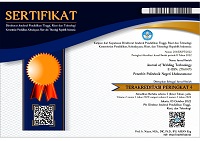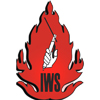Analysis of quenching temperature variations in the heat straightening processFor multiple ripair FCAW welding HSLA SM490YA material
Abstract
In the steel structure fabrication industry, girders play a crucial role as supporting beams during construction. The girder's components include end plates and beams, with the end plate serving as a critical connection point for the beam to the column. Welding at this juncture demands careful consideration. This analytical research focuses on the impact of multiple repair welding and quenching temperatures during the heat straightening process on the toughness and microstructure of HSLA SM490YA material, utilizing FCAW welding. To assess the effects of multiple repair welding, the study compares different repair scenarios—welding without repair, two repairs, and three repairs, all performed at a 50% depth. Subsequently, the heat straightening process occurs at a temperature of 650ºC on the repaired material. Post-heat straightening, quenching is carried out with temperature variations of 650ºC, 475ºC, and 300ºC. The findings indicate that the repair process during welding and subsequent quenching after the heat straightening process leads to a decrease in toughness values. This results in a finer grain size, with the material phase predominantly composed of pearlite. These research outcomes should be carefully considered by industry professionals, particularly in critical connections, when determining quenching temperatures after the heat straightening process in repair procedures.
Keywords
Full Text:
PDFReferences
AWS D1.1/D1.1M, Structural Welding Code - Steel An American National Standard, American Welding Society, 2020.
H. Wiryosumarto, Teknologi pengelasan logam, Jakarta, 2000, p. 425.
Y. M. V. A. H. &. C. R. J. Sohn, "Effects of Imperfections in Heat Straightening Repair of Steel Beam Bridges," 2018.
W. Nash, "Schaum’s Outline of Strength of Materials," Schaum’s Outline of Strength of Materials, FourthEdition, 1998.
T. S. Rajan, "Heat Treatment Principlea and Technique," Prentice Hall of India Private Limited. New Delhi, 1997.
AWS D1. 7/D1.7M:20, Guide For Strenghtening - Steel An American National Standard. In American Welding Society, American, 2010.
Japanese Industrial Standart. JIS G 3106 Roled Steel for Welded Structure, Japan: Japanese Standards Association, (2016).
W. Baldwin, Metallography and Microstructures. Metallography and Microstructures, 2004.
Suharno, "Struktur Mikro Las Baja C-Mn Hasil Pengelasan Busur Terendam dengan Variasi Masukan Panas," Jurnal Teknik Mesin, Vols. 10(1),, no. https://doi.org/10.9744/jtm.10.1.pp.40-45, pp. 40-45–45, 2009.
M. S. Amri, H. B. Kurniyanto, u. E. Suyono and I. K. Rohmat, "Analisis Multiple Repair Pada Material Baja Karbon SA 333 Grade 6 Dengan Proses GTAW Terhadap Kekerasan, Ketangguhan, Dan Struktur Mikro," Jurnal INOVTEK Polbeng, vol. 12, pp. 15-22, 2022.
DOI: http://dx.doi.org/10.30811/jowt.v5i2.4633
Refbacks
- There are currently no refbacks.

This work is licensed under a Creative Commons Attribution-ShareAlike 4.0 International License.
Ciptaan disebarluaskan di bawah Lisensi Creative Commons Atribusi-BerbagiSerupa 4.0 Internasional.
Mailing Address:
Politeknik Negeri Lhokseumawe
Jl. Banda Aceh-Medan
Km. 280,3, Buketrata, Mesjid Punteut, Blang Mangat,
Kota Lhokseumawe, 24301
Propinsi Aceh,
Indonesia























